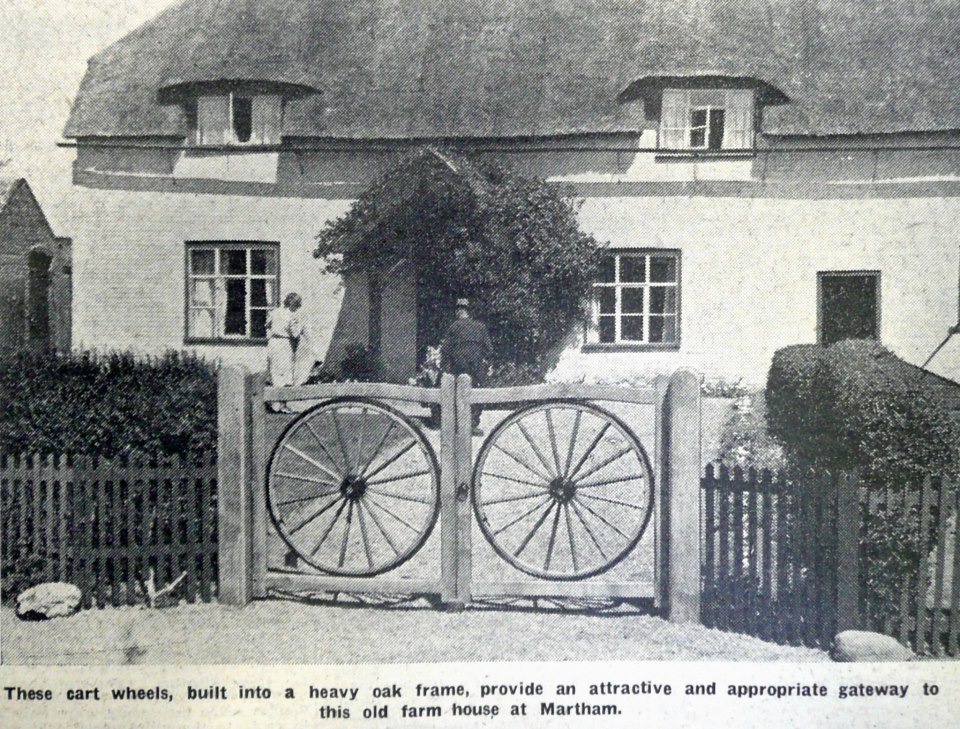Clarkes Farm, Staithe Road, Martham
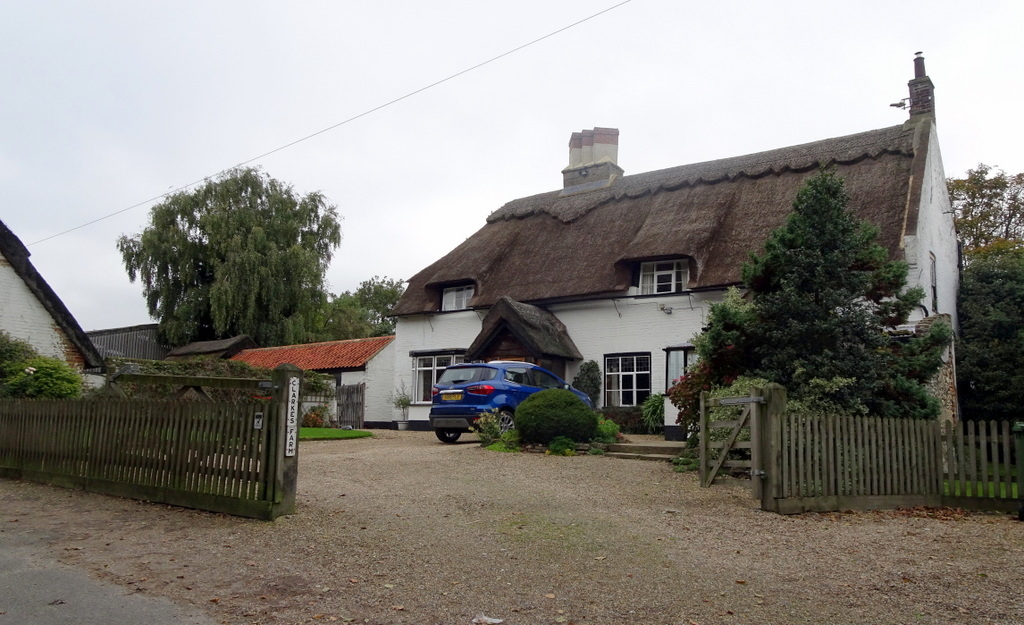
Sometimes historically recorded as Clark Farm or Clarks Farm or Clarke’s Farm but mostly Clarkes Farm, I have used the latter spelling throughout for consistency. Throughout its history Clarkes Farm has been closely linked with Moregrove and you may like to read the pages about Moregrove as well as these.
The source of the name of the house and farm probably refers to the original builder/owner. There is a very early 15th century reference to a Roger Clarke who was an important contributor to the cost of a stained-glass window at the north aisle of St Mary’s in 1449 that is undoubtably linked with Clarkes Farmhouse. There are also early records listing Land Tax payments made by a John Clarke in 1782, 1784, 1798 and 1800. Land Tax records list payments made but not the property they were made for. John Clarke was married to Sarah Cadge at Scottow in 1791 and they had eight children who were all baptised at St Mary’s between 1792 to 1802.
Clarkes Farmhouse is an Historic England grade II listed building (ref No 1372911). It was listed on 4th December 1987 and described as follows: Early circa 16th century farmhouse which was greatly altered in the 18th century when the timber framed structure was re-fronted, brick skinned and whitewashed. It has a thatched roof. Lobby entrance. South facing front of one storey and dormer attic. There is a circa 20th century brick timber and glazed porch and a bay window to the left of a similar date. To the right is a 3-light 18th century casement window. A small glazed lower addition of 20th century date has been added to the right façade. It has a gabled roof, hipped to the west. There are two through-eave dormers under eyebrow thatching, both with 3-light casements. Over the door is a triple diamond flue ridge chimney stack on a rectangular plinth, the flues have been rebuilt. There is an internal chimney stack to the east gable end. The rear has a full length 20th century pantiled small addition plus two dormers under eyebrow thatching. Inside there are close studded heavy timber beam cross sections. The lounge has a 16th century multiple rolled bridging beam. There is a winding staircase by the chimney stack. There is a blocked up mullioned window remaining under the eaves to the rear and an original Queen post remains in the roof but otherwise it has all been renewed.
The 1812 Inclosure Award map shows the farmhouse plus three other cottages, barns and outbuildings all within the farm complex. The farmhouse, yard and cottages were at the south corner of an estate amounting to about 130 acres which was owned by Benjamin Rising. The extent of his land holding in 1812 is shown outlined in red on the copy of the 1812 Inclosure Award map shown below. Benjamin was part of the Rising family dynasty of farmers and landowners of Martham and West Somerton. In 1812 he also farmed the nearby Moregrove Manor estate and lived there although it was owned by Elizabeth Cookson at the time.
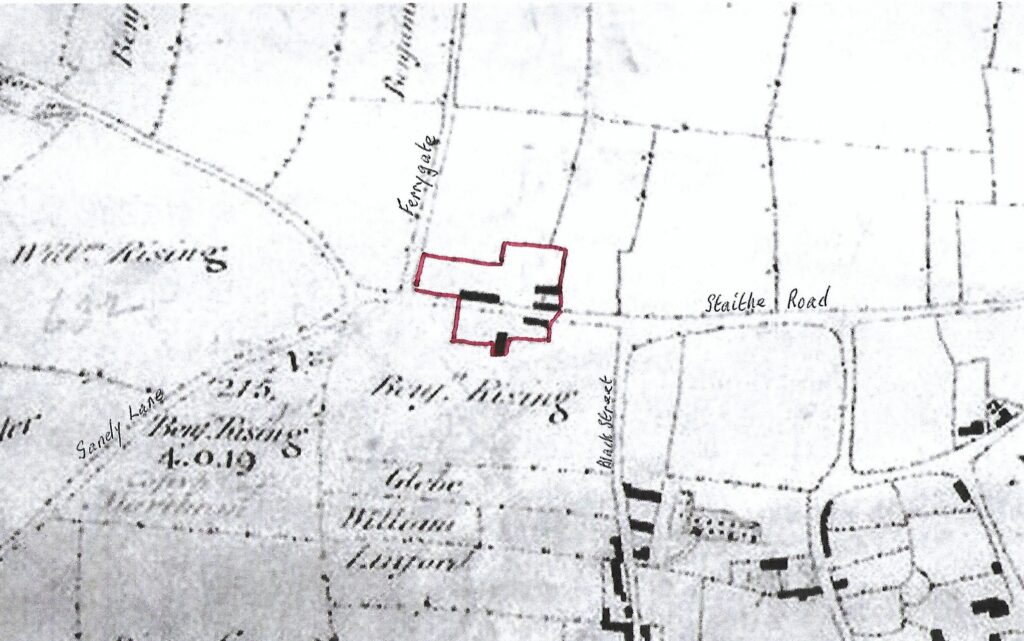
Benjamin Rising was also married to Mary Clementina who came from a family called Garnham of Itteringham. She was one of seven children of Richard Garnham & Mary, nee Cubitt. One of her brothers was William Henry Garnham (1797-1862). Benjamin & Mary did not have any children; she died in 1832 and when he died in 1835 his Will made it clear that his brother-in-law William Henry Garnham was to be his main heir. William therefore became the owner of Clarkes Farm (and Moregrove) and is listed as such in the 1842 Martham Tithe Award. The change of ownership from Benjamin Rising to William Henry Garnham happened in 1835 and included both Clarkes Farm and Moregrove. The owner of Moregrove remained William Henry Garnham in 1841 who was a very successful silk merchant and draper living at 30 Red Lion Square, London where his business was.
There then followed a confusing period of owner, annuity holder and occupier. From 1840 to 1853 the Registers of Electors tell us that a Robert Parker of Camberwell had an annuity out of land at Clarke’s Farm whilst William Henry Garnham was the owner. The same situation prevailed in 1854 and 1855 after Rev. George Pearse became the owner.
When owner William Henry Garnham lived in London, Clarkes Farm was occupied by a tenant and the associated cottages had farm workers living in them. In census returns all four are often referred to simply as Clarkes Farm which can make identification of those occupying the main house difficult. This was the situation in 1841 when the actual farmhouse was occupied by Robert Reeve and his wife Ann, nee Webster plus their five children. Robert was described in the census return for that year as a farmer. Robert died later that year in October 1841 and Ann moved to Cess, Martham. Three other families lived in the cottages and were all farm labourers, they were:
- William & Maria Utton plus their daughter Ann (2).
- William & Mary Utton plus their children John (20) & twins Edward & Daniel (15).
- John & Esther Parker plus their children John (15) & Clarissa (6).
As we have seen by 1842 William Henry Garnham had become a substantial landowner in Martham and the Tithe Award of that year shows he owned a total of just over 227 acres of land in the parish that included Clarkes Farm. The map below shows just the main plots surrounding Clarkes Farm itself. Plots 28 and 32 have become the Primary and Nursery Schools in modern times.
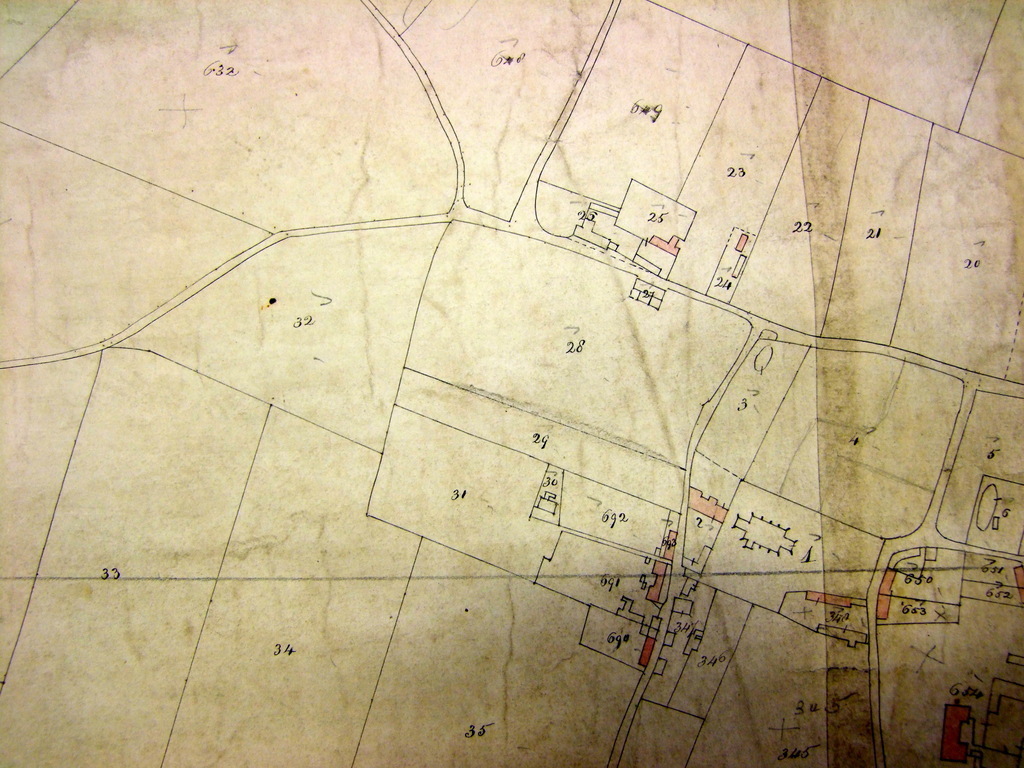
The 1851 census tells us that Robert Green and his wife Judith, nee Watson occupied the house. They were the tenant farmers of 123 acres employing 3 labourers.
Robert was listed as being at the farm in the 1857 Register of Electors and both Robert and Judith appear in the 1861 census when things became a little easier to understand as the main house was listed as “Clarks Farm” and the other three cottages as “Clarks Farm Road”. The road has always cut through the farmyard and is sometimes called Staithe Road and at other times Ferrygate Lane but it is the same place just near the junction of both. Below is a copy of the 1861 census page.
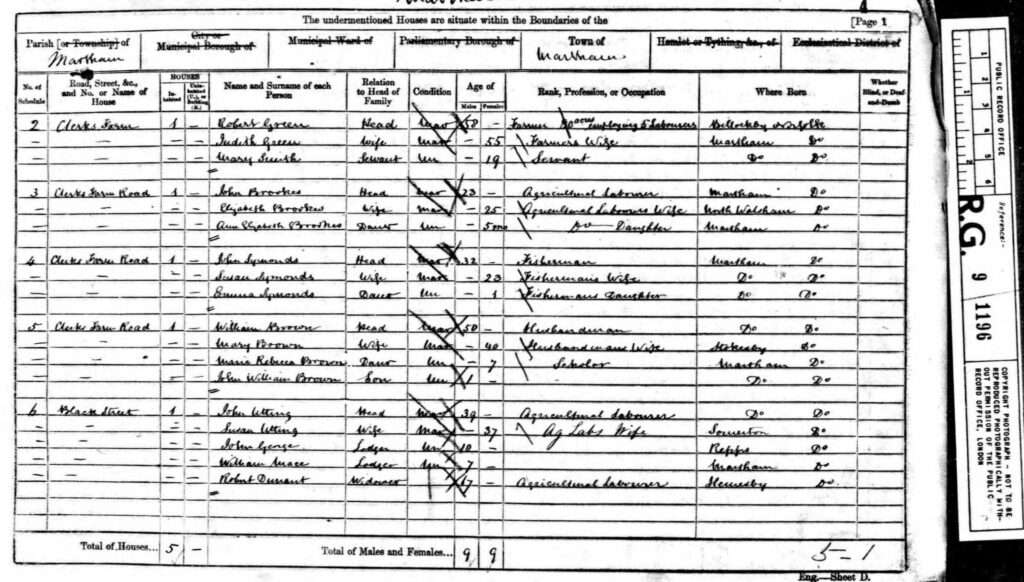
On 9th July 1853 an advert appeared in the Norfolk Chronicle announcing the auction of Clarkes Farm describing it as a farmhouse containing a parlour, kitchen, workhouse, dairy, pantry, cellar and four bedrooms plus a newly erected barn, range of piggeries, granary, cart horse stable and enclosed yards etc. and land amounting to 123 acres, 2 rods and 37 perches. The tenant was confirmed as being Robert Green who was paying £247 5s per annum rent. Moregrove was advertised for sale at the same auction to be held on 11th July indicating that it was William Henry Garnham who was the vendor. The advert is show below:
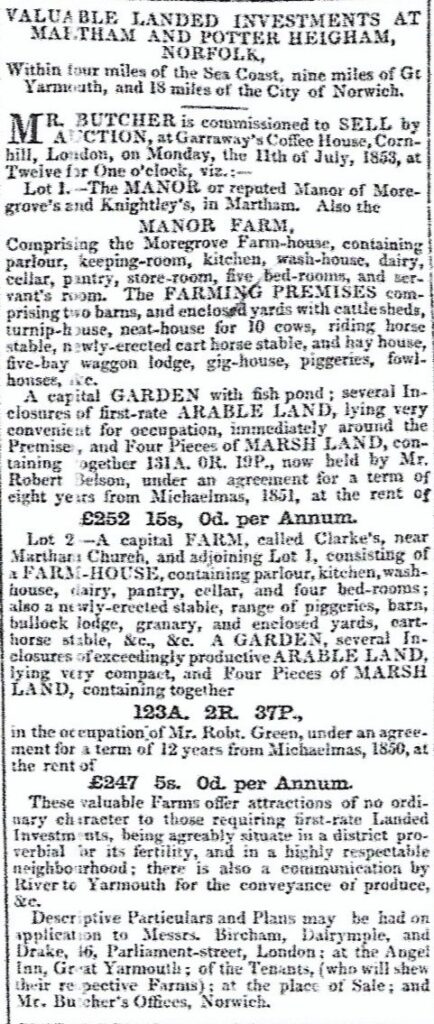
The buyer of all the properties was Reverend George Pearse who paid £10,900. Rev. Pearse was born at Carlton Colville, Suffolk in 1793 and was the Vicar of St Mary’s from 1834 until he retired in 1876. Rev. Pearse continued the tenancy held by Robert Green and he appears in the Register of Electors as owner of Clarkes Farm from 1853 to 1871. By the time of the 1871 census Robert Green had retired and had moved to The Green to live.
George Betts Collyer, who was born at Caister-on-Sea, had taken over Clarkes Farm and lived there with his wife Susanna, nee Morris as shown in the 1871 census.
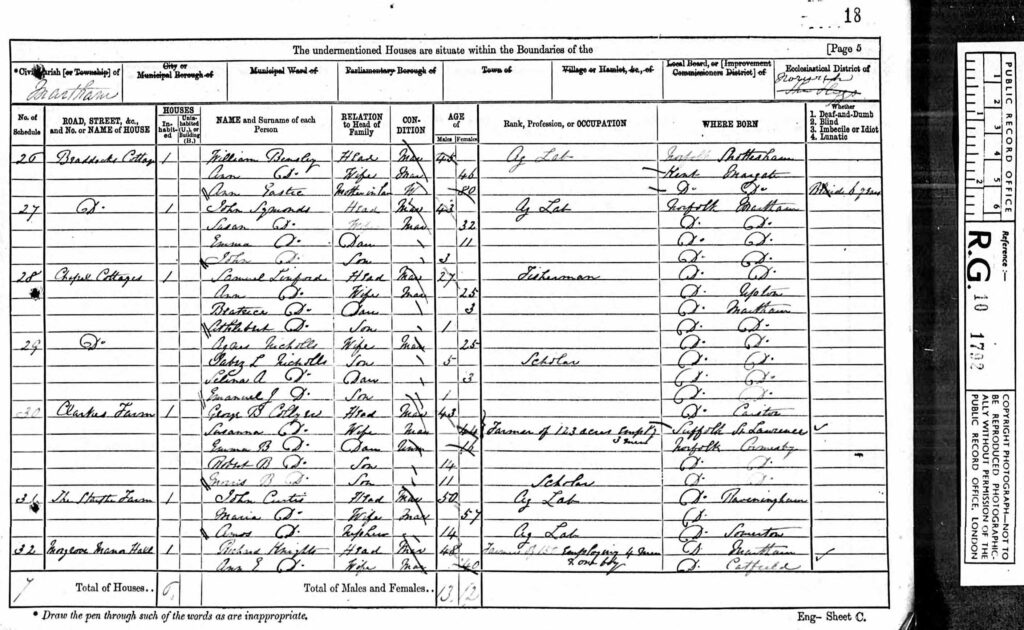
George appeared in Kelly’s Business Directories as a farmer at Clarkes Farm for the years 1874 to 1879 after which he moved to Moregrove where his father had been the tenant. He also appeared in the Register of Electors at Clarkes Farm for the years 1872 to 1879. George & Susanna had a son called Robert Betts Morris Collyer and in 1881 he had taken over from his father at Clarkes Farm and the census said he farmed 120 acres employing two men and one boy. He was also listed in the Register of Electors in 1882 in respect of Clarkes Farm.
Throughout the period that the Collyers had lived and farmed Clarkes Farm the owner had been Rev. George Pearse but he never lived there and died in Lancashire 5th September 1882. After his death Clarkes Farm came up for sale again (jointly with Moregrove). On 9th June 1883 the Norwich Mercury advertised that both farms would be auctioned on 7th July 1883 at Norwich. Below is a copy of the advert showing Clarkes Farm as being 123 acres, 2 rods & 38 perches.
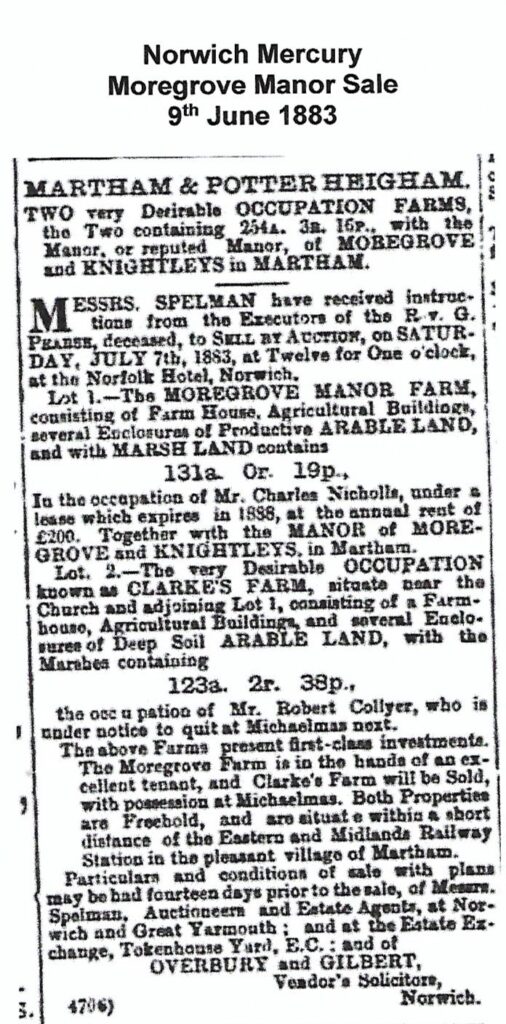
We do not know the outcome of the sale in 1883 although Moregrove was auctioned at the same time and the buyer was Charles Palmer who was an another investor rather than a farmer. He was a MRCS surgeon and lived at 44 King Street, Great Yarmouth, there is however no subsequent mention of him owning Clarkes Farm. In the meantime Benjamin Nichols was listed as living there according to the 1888 Register of Electors and the 1891 census which listed him and his wife Elizabeth, nee Howes, and their two children at the time who were Rosa (6) and Harry (2). In 1891 Benjamin’s father Charles lived and farmed at Moregrove. Shockingly Benjamin died only two years later aged just 27 and his wife, Elizabeth also died just five weeks after him leaving three orphaned children. It must have been a terrible shock and three years later when their grandfather, Charles, died he set up a trust fund for the children within the terms of his Will. By all accounts it seems that Charles Nichols then farmed both Moregrove and Clarkes Farm. In August 1896 Clarkes Farm was again put up for auction but was withdrawn at £2,700 according to the article shown below that appeared in the Thetford & Watton Times on 8th August 1896.
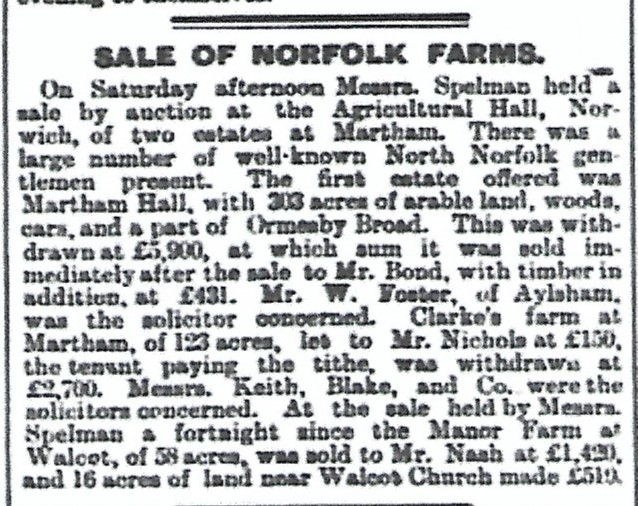
The link with the Nichols family at Clarkes Farm did not stop with the death of Benjamin or his father because Benjamin’s brother Edmund was living there in 1901 according to the census. Edmund’s wife was Julia Ann, nee Gallant, and in 1901 they had eight of their eventual 15 children living at the farm so it must have been quite crowded especially as they also had a live-in servant. Ten years later, by the time of the 1911 census, Edmund and his family had transferred to Moregrove.
The tenant in 1911 was John Johnson who lived there with his wife, Louisa, a daughter, mother-in-law and a grandaughter. He was 54 and was born in Repps. He was listed a being the farm bailiff in 1911.
George William Chapman (1837-1919)
In 1919 George William Chapman purchased Moregrove Farm and three other houses in Damgate. There was no record of him acquiring Clarkes Farm as well at that time but the farms had often been sold together and it seems likely that he bought the latter at the same time, or soon after purchasing Moregrove because the Chapman family have been associated with Clarkes Farm ever since.
George Chapman died in 1936 but his business was going strong at the time and he lived at Clarkes Farm as shown in this Martham carnival advert of 1936:
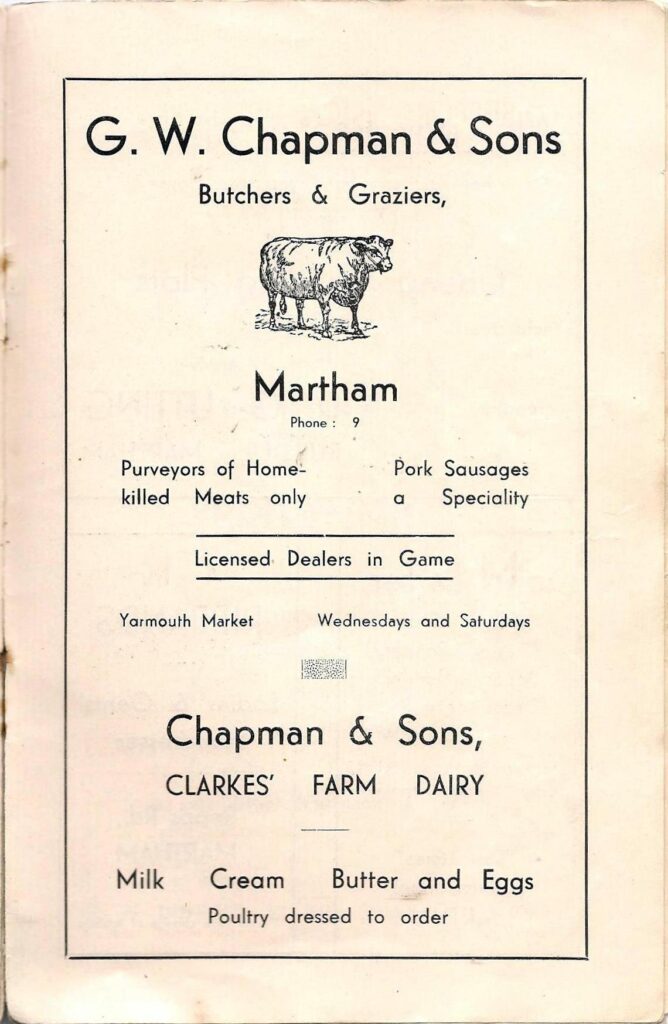
George had a son called William Rayner Chapman who married Kathleen Doris Francis in June 1938 and the St Mary’s Church register entry gives his address as Clarkes Farm. The couple are also recorded as living at Clarkes Farm in the 1939 National Register. Just for continuity, they had a son call Stuart who was baptised in 1940 and a daughter called Stephanie who was baptised in 1945 at St Mary’s and both church register entries give their address as Clarkes Farm. The family remain the owners to this day.
Clarkes Farm has graced the village of Martham for over 500 years and the Chapman family continue to care for the land as well as broadening its appeal in recent years by diversifying with farm open days, development of paddocks and a riding centre and over the last few years converting some of the old barns into Broadland Country Sports retail business that provides the very best in country clothing and equipment for walking, riding, fishing and shooting.
